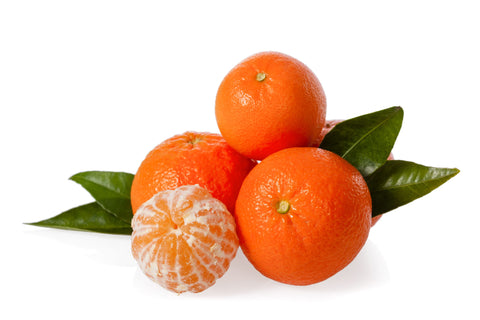Hidden Treasures: The Sweet World of Clementines

Once a winter classic, clementines and nuts were a must-have in Santa's sack. Today, clementines are no longer exclusively available in winter. And that's a good thing. These small citrus fruits are simply delicious. They're perfect for juicing, smoothies, and, above all, as a healthy snack between meals.
What you should know about clementines
Clementines are smaller than mandarins and, in most cases, seedless. They are sweet and have a very thin but robust skin. Clementines are often treated with pesticides.
Even though clementines are peeled before eating, you should still wash them thoroughly beforehand. It's best to soak them in vinegar or baking soda water immediately after purchasing. Let the fruit soak for a while, then rinse them thoroughly under running water. This will remove any residue. Dry the clementines thoroughly and store them loosely and without pressure in a fruit bowl. If you wash the clementines beforehand, you can grab them anytime without having to worry about any pesticide residue sticking to your fingers.
The origin of clementines

The clementine is said to have originated in 1902 in the garden of an orphanage in Algeria. A monk named Clement who worked there discovered this new fruit and gave it its name. What is certain, however, is that the clementine is likely a spontaneous hybrid.
It originated from bitter orange and mandarin orange. It's possible, of course, that clementines already grew before or at the same time in other parts of the world. There's a good chance that hybrids of these citrus fruits were also cultivated in Asia. After all, the citrus fruits owe their name to the Algerian monk.
The Clementine Season
In our latitudes, clementines are very popular, especially during the cold season.
This is because there are hardly any local fruits coming onto the market anymore and clementines are a great alternative to apples and pears.
In Asia, Africa, as well as the Americas and South America, clementines grow year-round. They could therefore reach our markets year-round, but they are not as popular during the summer months. Those traveling to Asia in the summer will find an enormous selection of clementines, mandarins, and oranges of all varieties in the markets. In Asia, clementines come in a wide variety of sizes, with mini clementines, with a diameter of 3 cm, being particularly popular.
The taste of clementines
Clementines are juicy and taste wonderfully sweet. Some fruits can also have a slightly sour note. In any case, they are refreshing and conjure up a bit of summer on cold winter days.
Ingredients & Effects - Properties of Clementines
Clementines are rich in vitamin C. This vitamin strengthens your defenses, supports your immune system, and protects your cells. The provitamin A contained in these citrus fruits has a positive effect on your eyesight.
Clementines are also good for your figure. If you're craving something sweet, reach for clementines. They're sweet and banish cravings for chocolate and the like. They also keep your fructose levels steady, meaning you won't get hungry again as quickly. Clementines are rich in antioxidants and flavonoids. They're a great anti-aging fruit that's good for connective tissue, cells, and the cardiovascular system.
Clementines vs. Mandarins - What's the Difference?

Clementines are usually somewhat smaller and flatter than mandarins. Clementines have a slightly lighter skin than mandarins. Clementines are also somewhat harder to peel than their relative, the mandarin orange. However, clementines are usually seedless or have few seeds.
How healthy are clementines?
Clementines are very healthy and generally well-tolerated. Of course, it's possible that someone might develop a citrus allergy, in which case, eating them is also not recommended. However, these small, sweet, and bright orange fruits are very digestible, and even their low acidity is well-tolerated.
However, if you take statin-based heart medication, you should consult your doctor about whether and how many clementines you can eat. Clementines contain furanocoumarins, which are not well-compatible with some medications. Therefore, a consultation is highly recommended.
Clementines are a great snack. They're perfect for taking to work, the gym, or school or university, as they're naturally packaged. However, make sure you always wash the peel beforehand. Otherwise, be sure to wash your hands thoroughly after peeling and before eating.
Nutritional values of clementines per 100 grams
Clementines are packed with essential vitamins, minerals, trace elements, and more. Here's a list of the benefits of these delicious, sweet citrus fruits.
100 grams of clementines contain:
|
46 kcal 0.7 g protein 0.3 g fat 9 g carbohydrates 86.1 g water 0 cholesterol 0.3 mg vitamin E 0.07 mg vitamin B1 |
15 µg folic acid 0.02 mg vitamin B2 30 mg vitamin C 0.05 mg vitamin B6 0.3 mg α-tocopherol 3 µg vitamin K 0.5 µg biotin |
Special: Clementine juice

Clementine juice isn't as popular in our part of the world; in Asia, for example, you'll find a clementine juice stand on every street. This delicious juice has a lot to say about it, as it's packed with good nutrients. It also has a pleasant sweetness with a light, delicate acidity. Clementine juice is also particularly aromatic. Especially in December, clementines are available in many supermarkets for a reasonable price. For a change, buy clementines and squeeze yourself a delicious juice from these citrus fruits.
🍋 Lemons
▷ The right citrus press - 10 points you should definitely consider when buying!
Bestsellers from Nutrilovers
Testimonials
What customers say about our customer service.
Frequently Asked Questions
Questions & Answers
Is "Nutrilovers" a German brand?
Yes - Nutrilovers is a German brand and company from Munich.
Our team consists of true Nutrilovers.
We love healthy eating because our well-being is our top priority.
Since 2015, we have been supporting people on their conscious path to life with a healthy diet every day.
How can I order and what is the delivery time?
You can easily order from us online here in our shop.
To do so, select your products and proceed to checkout. Once we receive your order, we'll work quickly to ensure your order is in your hands within 1-2 business days.
Can I return my orders if I don't like them?
Yes - you have a risk-free 30-day return policy.
Simply send us an email to mailme@nutrilovers.de , keyword: “Return” with your name, order number and address.
You can then drop off the package at any Deutsche Post or DHL service point.
The return address:
SW Commerce c/o Subke GmbH,
Lüner Rennbahn 26, 21339 Lüneburg,
Germany
Detailed information on thecancellation policy can be foundhere
What payment methods are available?
You can choose from different payment providers:
- credit card
- PayPal
- Skrill
- Payment via SOFORT transfer
- Invoice with Klarna
- Installment purchase with Klarna
- Google Pay
- Apple Pay
- Shop Pay
Is there a minimum order value?
There's no minimum order value at Nutrilovers. However, you'll receive free shipping within Germany for orders over EUR 99.00.
Does Nutrilovers offer replacement parts?
Yes , we usually have all
Spare parts in stock and if not, we can
Simply contact us via our
Contact form,
and tell us which Nutrilovers product you own and
which spare part you need.
How long is the warranty and guarantee valid?
We provide a 24-month warranty on new devices and a 12-month warranty on used devices.
Months.
In addition to the legally required 2-year warranty, Nutrilovers offers a 3-year warranty on the motor. (You can find the corresponding warranty terms and conditions here .)
If anything happens, we are available at any time and will take care of it - even after the statutory warranty period has expired.
Does Nutrilovers also help with questions and problems after the purchase?
Always! Simply contact us via our support center and we'll get back to you within 24 hours on weekdays.





















